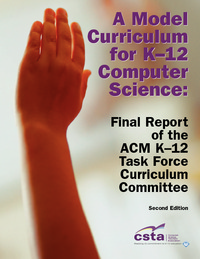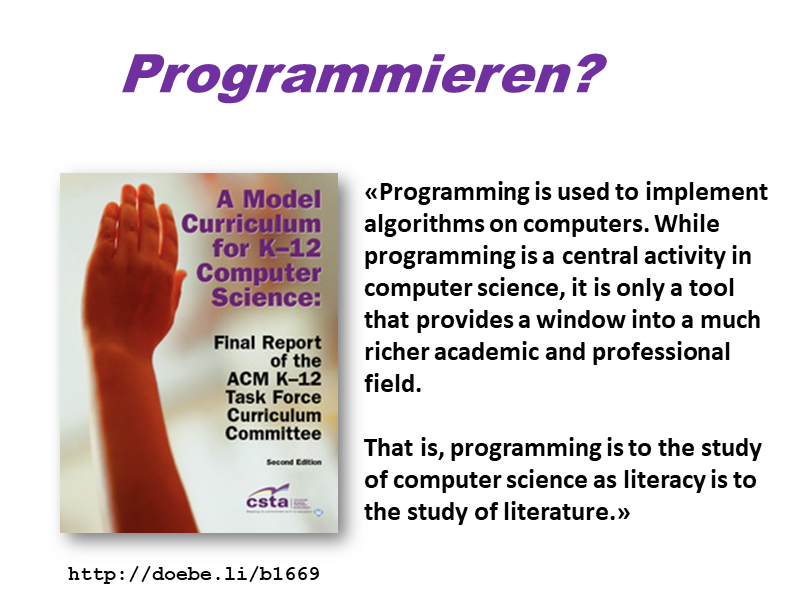A Model Curriculum for K-12 Computer ScienceFinal Report of the ACM K-12 Education Task Force Curriculum Committee
|

|
 Zusammenfassungen
Zusammenfassungen
 This report proposes a model curriculum that can be used to integrate computer science fluency and competency throughout primary and secondary schools, both in the U.S. and throughout the world. It is written in response to the pressing need to provide academic coherence to the rapid growth of computing
and technology in the modern world, alongside the need for an educated public that can utilize that technology most effectively to the benefit of humankind.
This report proposes a model curriculum that can be used to integrate computer science fluency and competency throughout primary and secondary schools, both in the U.S. and throughout the world. It is written in response to the pressing need to provide academic coherence to the rapid growth of computing
and technology in the modern world, alongside the need for an educated public that can utilize that technology most effectively to the benefit of humankind.Computer science is an established discipline at the collegiate and post-graduate levels. Oddly, the integration of computer science concepts into the K-12 curriculum has not kept pace in the United States. As a result, the general public is not as well educated about computer science as it should be, and a serious shortage of information technologists at all levels exists and may continue into the foreseeable future. This curriculum model aims to help address these problems. It provides a framework within which state departments of education and school districts can revise their curricula to better address the need to educate young people in this important subject area, and thus better prepare them for effective citizenship in the twenty-first century.
This curriculum model provides a four-level framework for computer science, and contains roughly the equivalent of four half-year courses (many of these can be taught as modules, integrated among existing science and mathematics curriculum units). The first two levels suggest subject matter that ought to be mastered by all students, while the second two suggest topics that can be elected by students with special interest in computer science, whether they are college-bound or not. The Appendix to this report provides “proof of concept” by outlining existing courses and modules that are now being taught in different school districts at each of the four levels.
These recommendations are not made in a vacuum. We understand the serious constraints under which school districts are operating and the up-hill battle that computer science faces in the light of other priorities, as well as time and budget constraints. Thus, we conclude this report with a series of recommendations that are intended to provide support for a long-term evolution of computer science in K- 12 schools. Many follow-on efforts will be needed in order to sustain the momentum that this report will hopefully create. Teacher training, curriculum innovation, in-class testing, textbook and Web site development, and dissemination are but a few of the challenges. We hope that this report will serve as a catalyst for widespread discussions and the initiation of many pilot projects that can take the evolution of K-12 computer science to the next level. We invite you to read the entire report, and then to take part in this discussion in a way that mutually benefits both you and the K-12 education community.
 in der Broschüre A Model Curriculum for K-12 Computer Science (2003)
in der Broschüre A Model Curriculum for K-12 Computer Science (2003)  Diese Broschüre erwähnt ...
Diese Broschüre erwähnt ...
 Personen KB IB clear | Seymour Papert | ||||||||||||||||||
 Aussagen KB IB clear | Informatik ist mehr als Programmierencomputer science is more than programming | ||||||||||||||||||
 Begriffe KB IB clear | Curriculum / Lehrplancurriculum
, Informatikcomputer science
, Informatik-Unterricht (Fachinformatik)Computer Science Education
,  Programmieren Programmieren programming
, programming
,  turtle graphics turtle graphics
| ||||||||||||||||||
 Bücher |
|
 Diese Broschüre erwähnt vermutlich nicht ...
Diese Broschüre erwähnt vermutlich nicht ... 
 Nicht erwähnte Begriffe | Informatik-Didaktik, Informatikunterricht in der Schule, Lehrplan 21 |
 Tagcloud
Tagcloud
 Vorträge von Beat mit Bezug
Vorträge von Beat mit Bezug
 Zitationsgraph
Zitationsgraph
 Zitationsgraph (Beta-Test mit vis.js)
Zitationsgraph (Beta-Test mit vis.js)
 Zeitleiste
Zeitleiste
 9 Erwähnungen
9 Erwähnungen 
- INFOS 2007 - Didaktik der Informatik in Theorie und Praxis - 12. GI-Fachtagung Informatik und Schule (Sigrid E. Schubert) (2007)
- Einstieg Informatik - Aktivitäten und Erfahrungen (Wolfgang Pohl, Katharina Kranzdorf, Hans-Werner Hein)


- Einstieg Informatik - Aktivitäten und Erfahrungen (Wolfgang Pohl, Katharina Kranzdorf, Hans-Werner Hein)
- Fachdidaktische Diskussion von Informatiksystemen und der Kompetenzentwicklung im Informatikunterricht (Peer Stechert) (2009)


- SIGCSE 2010 - Proceedings of the 41st ACM technical symposium on Computer science education, SIGCSE 2010, Milwaukee, Wisconsin, USA, March 10-13, 2010 (Gary Lewandowski, Steven A. Wolfman, Thomas J. Cortina, Ellen Lowenfeld Walker) (2009)
- Braided Teaching in Secondary CS Education - Contexts, Continuity, and the Role of Programming (Arno Pasternak, Jan Vahrenhold) (2010)


- Braided Teaching in Secondary CS Education - Contexts, Continuity, and the Role of Programming (Arno Pasternak, Jan Vahrenhold) (2010)
- Guide to Teaching Computer Science (Orit Hazzan, Tami Lapidot, Noa Ragonis) (2011)

- Informatics in Schools - Contributing to 21st Century Education (Ivan Kalas, Roland Mittermeir) (2011)

- Fach- und bildungswissenschaftliche Grundlagen für den Informatikunterricht in der Sekundarstufe I (Arno Pasternak) (2013)


- ISSEP 2014 - Informatics in Schools - Teaching and Learning Perspectives (Yasemin Gülbahar, Erinç Karataş) (2014)


- 10. Measuring Student Competences in German Upper Secondary Computer Science Education (Jonas Neugebauer, Peter Hubwieser, Johannes Magenheim, Laura Ohrndorf, Niclas Schaper)


- 10. Measuring Student Competences in German Upper Secondary Computer Science Education (Jonas Neugebauer, Peter Hubwieser, Johannes Magenheim, Laura Ohrndorf, Niclas Schaper)
- WiPSCE 2014 - Proceedings of the 9th Workshop in Primary and Secondary Computing Education, Berlin, Germany, November 5-7, 2014 (Carsten Schulte, Michael E. Caspersen, Judith Gal-Ezer) (2014)
- Starting from scratch - experimenting with computer science in Flemish secondary education (Francis Wyffels, Bern Martens, Stefan Lemmens) (2014)


- Starting from scratch - experimenting with computer science in Flemish secondary education (Francis Wyffels, Bern Martens, Stefan Lemmens) (2014)
- Past, Present and Future of Computing Education Research (Mikko Apiola, Sonsoles López-Pernas, Mohammed Saqr) (2023)


- Computing Education Research in Baltic Countries (Valentina Dagienė, Mart Laanpere, Juris Borzovs)


- Computing Education Research in Baltic Countries (Valentina Dagienė, Mart Laanpere, Juris Borzovs)
 Co-zitierte Bücher
Co-zitierte Bücher

An enrichment and extension programme for primary-aged children
(Tim Bell, Ian H. Witten, Mike Fellows) (2006)

 Volltext dieses Dokuments
Volltext dieses Dokuments
 |  A Model Curriculum for K-12 Computer Science: Final Report of the ACM K-12 Education Task Force Curriculum Committee ( A Model Curriculum for K-12 Computer Science: Final Report of the ACM K-12 Education Task Force Curriculum Committee ( : :  , 345 kByte; , 345 kByte;  : :  2021-03-21) 2021-03-21) |
 Standorte
Standorte 
 Anderswo suchen
Anderswo suchen 
 Beat und diese Broschüre
Beat und diese Broschüre
Beat war Co-Leiter des ICT-Kompetenzzentrums TOP während er diese Broschüre ins Biblionetz aufgenommen hat. Die bisher letzte Bearbeitung erfolgte während seiner Zeit am Institut für Medien und Schule. Beat besitzt kein physisches, aber ein digitales Exemplar. (das er aber aus Urheberrechtsgründen nicht einfach weitergeben darf). Aufgrund der wenigen Einträge im Biblionetz scheint er es nicht wirklich gelesen zu haben. Beat hat diese Broschüre auch schon in Vorträgen erwähnt.












 Biblionetz-History
Biblionetz-History